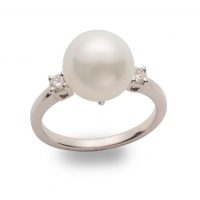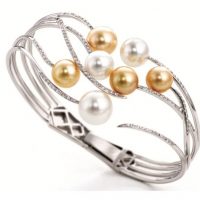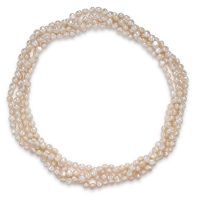
For centuries, pearls have been a symbol of beauty and purity. Today, they are regarded as both classic and contemporary, coming in many more fashionable styles than your grandmother’s traditional strand of pearls.
Learning about types of pearls is important when adding items to your jewelry collection.
Pearls, natural or cultured, are formed when a mollusk produces layers of nacre (pronounced NAY-kur) around some type of irritant inside its shell. In natural pearls, the irritant may be another organism from the water. In cultured pearls, a mother-of-pearl bead or a piece of tissue is inserted (by man) into the mollusk to start the process.
For both, the quality of the nacre dictates the quality of the luster, or shine of the pearl, which is very important to its beauty and its value. The surface of the pearl should be smooth and free of marks while the overall shape could be round, oval, pear-shaped, or even misshapen. Misshapen pearls are called baroque pearls.
While shopping for pearls, there are various lengths available:
Necklaces can also be classified as uniform (where all pearls are about the same size) or graduated (pearls change uniformly from ends to center).
Natural pearls are extremely rare. Historically, many were found in the Persian Gulf; unfortunately, today, most have already been harvested. You may be able to purchase small, natural pearls, but they will be costly.
Cultured pearls are grown in pearl farms. The mollusks are raised until they are old enough to accept the mother-of-pearl bead nucleus. Through a delicate surgical procedure, the technician implants the bead and then the mollusks are returned to the water and cared for while the pearl forms.
Not all produce a pearl; and not all the pearls are high quality. Over 10,000 pearls may be sorted before a 16” single strand of beautifully matched pearls is assembled.
Pearls can be found in saltwater and in freshwater. There are also different types of mollusks that produce very different looking pearls.

Saltwater pearls include the akoya cultured pearls grown in Japanese and Chinese waters. They range in size from 2mm (tiny) to 10mm (rare) and are usually white or cream in color and round in shape.
Australia, Indonesia, and the Philippines produce the South Sea pearl – the largest of all the pearls. They range in size from 9mm to 20mm and can be naturally white, cream, or golden in color.
Tahitian pearls are interestingly not exclusively from Tahiti – they’re grown in several of the islands of French Polynesia, including Tahiti. Their typical sizes range from 8mm to 16mm. These naturally colored pearls are collectively called black pearls, but their colors include gray, blue, green, and purple.

These pearls are grown in freshwater lakes, rivers, and ponds, predominately in China. Although many are white and resemble the akoya cultured pearls in shape and size, they can also be produced in various shapes and in an array of pastel colors.
Many freshwater pearls don’t have a bead nucleus — only a piece of tissue — resulting in a pearl with thicker nacre than the akoya.

Imitation pearls are usually a coated glass bead. Most have a high luster, but not the depth of luster seen on high quality cultured pearls.
It’s possible to separate an imitation from a cultured or natural pearl. It can be a challenge, though, to determine if the pearl is cultured or natural. And, many pearls undergo treatments to either enhance their luster or alter their color.
Since this treatment affects their value, you will want to obtain the educated advice of a top jeweler, such as the certified gemologists of the American Gem Society.
Learn more about precious metals or diamonds.
Natural pearls are extremely rare. Historically, many were found in the Persian Gulf; unfortunately, today, most have already been harvested. You may be able to purchase small, natural pearls, but they will be costly.
To find the perfect pearls, visit your local AGS jeweler.
Copyright © 2025 American Gem Society